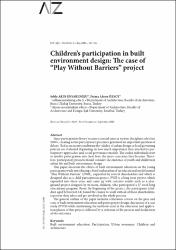| dc.contributor.author | Arın, Ensarioğlu, Sebla | en_US |
| dc.contributor.author | Özsoy, Fatma Ahsen | en_US |
| dc.date.accessioned | 2022-09-30T08:36:23Z | |
| dc.date.available | 2022-09-30T08:36:23Z | |
| dc.date.issued | 2021-07 | |
| dc.identifier.citation | Arın, E. S. & Özsoy, F. A. (2021). Children’s participation in built environment design: The case of “Play Without Barriers” project. A|Z ITU Mimarlık Fakültesi Dergisi, 18(2), 347-364. doi:10.5505/itujfa.2021.52386 | en_US |
| dc.identifier.issn | 2564-7474 | |
| dc.identifier.uri | https://hdl.handle.net/11729/4920 | |
| dc.identifier.uri | http://dx.doi.org/10.5505/itujfa.2021.52386 | |
| dc.identifier.uri | https://search.trdizin.gov.tr/yayin/detay/518634 | |
| dc.description.abstract | Since participation theory became a crucial issue in various disciplines after late 1960’s, creating actual participatory processes generated an important question of debate. Today, in recent conditions the validity of urban design or local governing policies are evaluated depending on how much importance they attached to participatory approaches and social governance models. The earlier individuals start to involve participation into their lives, the more conscious they become. Therefore, participatory projects should consider the existence of youth and children in urban life and built environment design. This paper discusses the effects of built-environment education on the young participants while introducing a brief explanation of an educational model named “Play Without Barriers” (PWB), supported by several shareholders and which is designed also as a child participation project. PWB is a long term project which expanded into three years and came up with concrete results such as a playground project designed by its users, children, who participated a 27 week long educational program. From the beginning of the project, the participants (children aged between 8-14) found the chance to work with all of these shareholders, represent their ideas and get involved in the whole process. The general outline of the paper includes a literature review on the pros and cons of built environment education and participatory design, discussion of a case study (PWB) while mentioning the methods used in the education and application phases of this project, followed by a criticism of the process and declaration of the outcomes. | en_US |
| dc.language.iso | eng | en_US |
| dc.publisher | İTÜ Rektörlüğü | en_US |
| dc.rights | info:eu-repo/semantics/openAccess | en_US |
| dc.subject | Built environment education | en_US |
| dc.subject | Participation | en_US |
| dc.subject | Urban awareness | en_US |
| dc.subject | Children and architecture | en_US |
| dc.title | Children’s participation in built environment design: the case of “Play Without Barriers” project | en_US |
| dc.type | article | en_US |
| dc.description.version | Publisher's Version | en_US |
| dc.relation.journal | A|Z ITU Mimarlık Fakültesi Dergisi | en_US |
| dc.contributor.department | Işık Üniversitesi, Sanat, Tasarım ve Mimarlık Fakültesi, Mümarlık Bölümü | en_US |
| dc.contributor.department | Işık University, Faculty of Art, Design and Architecture, Department of Architecture | en_US |
| dc.contributor.authorID | 0000-0003-0326-1882 | |
| dc.identifier.volume | 18 | |
| dc.identifier.issue | 2 | |
| dc.identifier.startpage | 347 | |
| dc.identifier.endpage | 364 | |
| dc.peerreviewed | Yes | en_US |
| dc.publicationstatus | Published | en_US |
| dc.relation.publicationcategory | Makale - Ulusal Hakemli Dergi - Kurum Öğretim Elemanı | en_US |
| dc.contributor.institutionauthor | Özsoy, Fatma Ahsen | en_US |
| dc.relation.index | TR-Dizin | en_US |


















